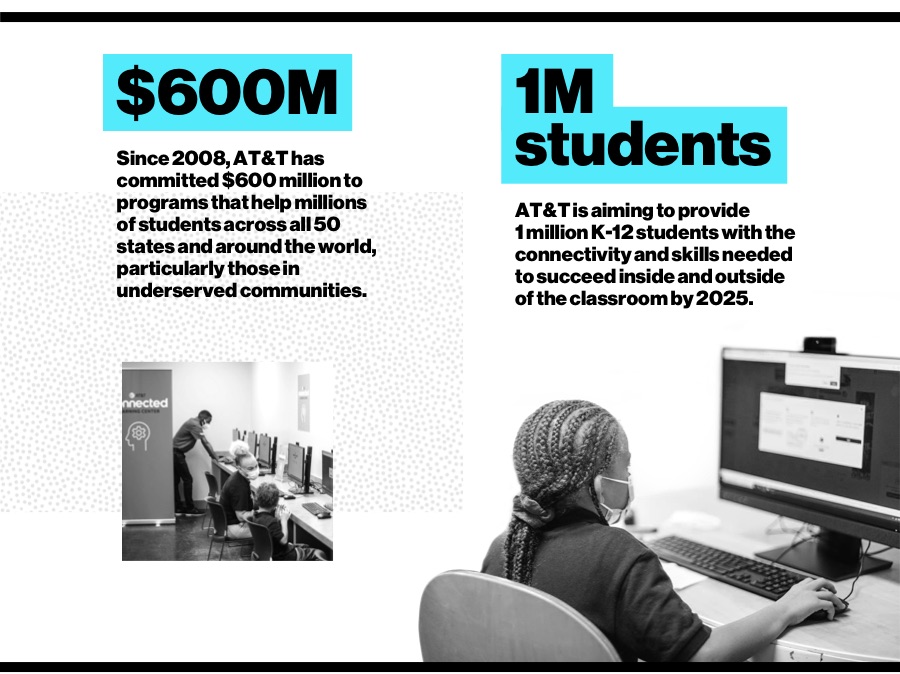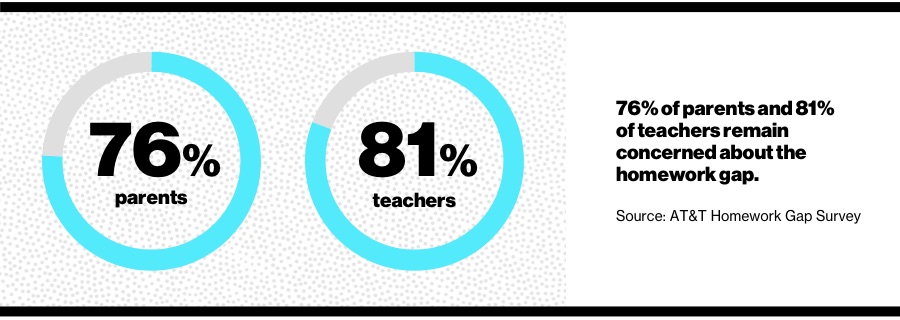Inside AT&T’s Innovative Programs to Improve Education Access and Close the Homework Gap
Across the United States, an estimated 17 million K–12 students, according to the FCC, lack access to broadband internet, required for online learning. The Covid-19 pandemic exacerbated this homework gap which has disproportionately impacted children in rural communities and low-income households; one in three students of color lack high-speed internet at home. When the pandemic forced over 55 million students into online learning, many families resorted to the use of personal smartphone hotspots and rolling Wi-Fi-enabled school buses to help their children complete their assignments.
AT&T is one of the largest providers of broadband internet in the U.S., with 17 million customer locations in nearly 100 metros in the United States. For more than a decade, the telecommunications giant has been working to address issues related to education, including high school graduation, digital skills building, job readiness and connectivity. Since 2020, AT&T has turned its focus to closing the homework and home connectivity gap as it relates to the digital divide.
In November 2020, AT&T began offering discounted unlimited wireless data plans and content services to more than 135,000 public and private K–12 schools, colleges and universities. The Dallas-based company also made a $10 million commitment to support at-risk students disconnected from learning by providing internet connectivity. And this April, the company made a $2 billion, three-year commitment to help bridge the digital divide.
“We want to get this accomplished by 2025,” says Corey Anthony, AT&T’s Chief Diversity and Development Officer. “So that is a significant undertaking on our part, but we’re committed to doing this work right. It’s trying to provide over a million K-through-12 students with the technology and or skills needed to succeed through the AT&T Connected Learning Program.”

To help reach these ambitious goals, AT&T is launching 20 Connected Learning Centers around the country in traditionally underserved communities where residents face significant barriers to connectivity. The first center opened in September in Dallas, where an estimated 54,000 K–12 students are without home internet service. For this center, AT&T has partnered with Family Gateway, a local nonprofit that provides support services to children and families affected by homelessness, and Dell Technologies has donated Dell OptiPlex computers and Dell monitors that feature technology to support virtual learning and digital literacy.
For AT&T, whose business is built on providing millions of people with the technological access they need to run their lives, access for all is a guiding principle and mandate at the company.
“You cannot expect any community to be able to overcome some of the challenges that disadvantaged communities face without broadband access,” says Anthony. “Because access to broadband, access to the internet, is just key and critical to any and everything we do now, education being at the top of that list. Now that we’re approaching two years in this pandemic, it’s become even more acute where we have communities that don’t have adequate access to it.”
Amplifying impact with supplier diversity
Overland-Tandberg, a Black-owned global technology and IT services company, was specifically selected to direct the configuration of the computers at the Connected Learning Centers. The company is among the many U.S. Black-owned suppliers with whom AT&T committed to spend a total of $3 billion by the end of 2020.
“One of the added benefits in working with a minority-owned business is you get to amplify that impact because of the work that they also do in the communities,” Anthony says. “And it aligns perfectly with our support of minority-owned businesses.”
The presence of these Black contractors at the centers can also be inspiring for the students. During the launch of the Dallas Connected Learning Center, students were able to observe Overland-Tandberg technicians performing their jobs.
“One of the students in that center approached us and talked about how cool it was to be able to see a person that looked like him doing this work with respect to technology,” Anthony says. “To be able to see Black and brown technicians in that center installing that technology, that network inside of that building, and creating the WIFI connections that this kid was going to be using, really brought it to life for all of us in terms of amplifying the impact.”
Supporting careers for women in technology
Partnering with Girls Who Code, an organization building a pipeline of future technologists and serving 450,000 girls globally, half of whom are Black, Hispanic/Latino or low-income, AT&T is able to bridge the homework gap and drive the need for economic empowerment and workforce development in these underserved communities.

During a time when almost 2 million women left the workforce due to the pandemic, AT&T is working to increase the number of and retain women and girls in STEM careers.
AT&T has hosted the Girls Who Code Summer Immersion Program since 2013, and in 2018, AT&T donated $1 million to support the organization’s summer coding camps, with the goal of closing the gap for women in STEM-related fields. Thousands of girls have learned to code through the AT&T support programs.
“If you can’t see it, you can’t be it,” Anthony says. “And so, it’s really important that Girls Who Code not only helps facilitate these girls moving into tech fields, but also give examples of women who are being successful in these fields.”
Building a culture of access through employee groups
None of this work happens at AT&T without the leadership of the company’s 54 employee groups, which represent more than 145,250 people.
“They’re the vanguards of our culture in this company, they’re the first line of defense,” says Anthony. “We have a model where it isn’t an executive like me who actually leads them. It’s the employees that are taking care of our customers. They actually lead these organizations, which makes it really meaningful for our culture and for them, and we see the impacts of that on the communities.”
At the Connected Learning Centers, local employee groups will play a key role in the programming by volunteering their time to provide tutoring and mentoring services.
“They bring to life in a very tangible way the DE&I work that we do at AT&T,” Anthony says. “The communities can put a face with that work in a way that, without [the employees], we would struggle to do as a company the size of ours, but they make it personal. They bring it to life on a very local basis, in a very personal, community-based way. That is just powerful.”
AT&T is a signatory of CEO Action for Diversity & InclusionTM, a coalition founded in 2017 on a shared belief that diversity, equity and inclusion is a societal issue, not a competitive one, and that collaboration and bold action from the business community—especially CEOs—is vital to driving change at scale. More than 2,000 CEOs have pledged to create a more diverse, inclusive and equitable workforce.
